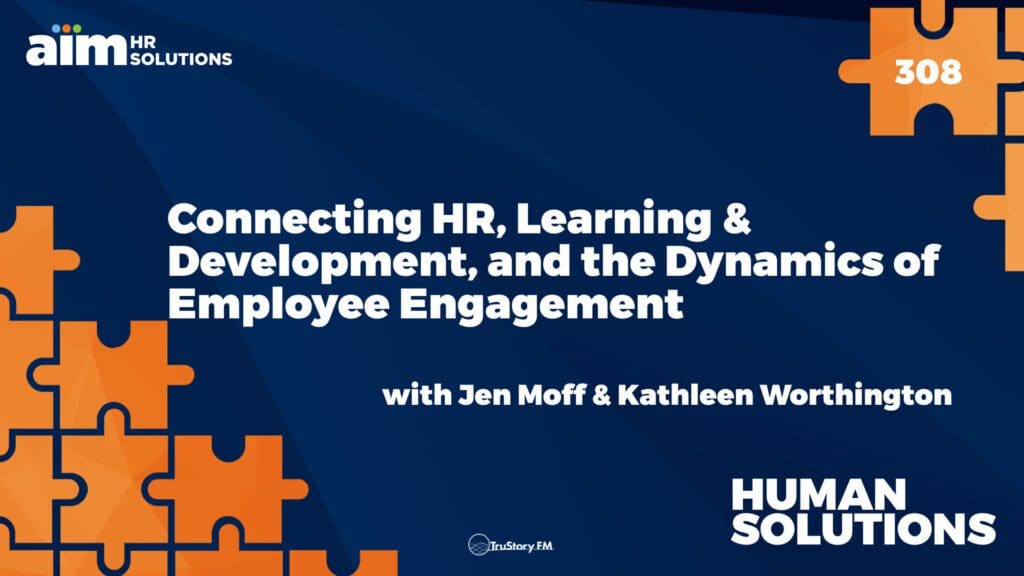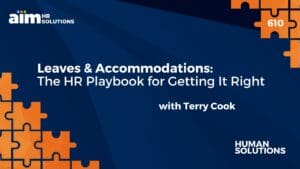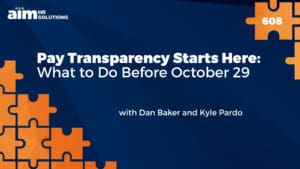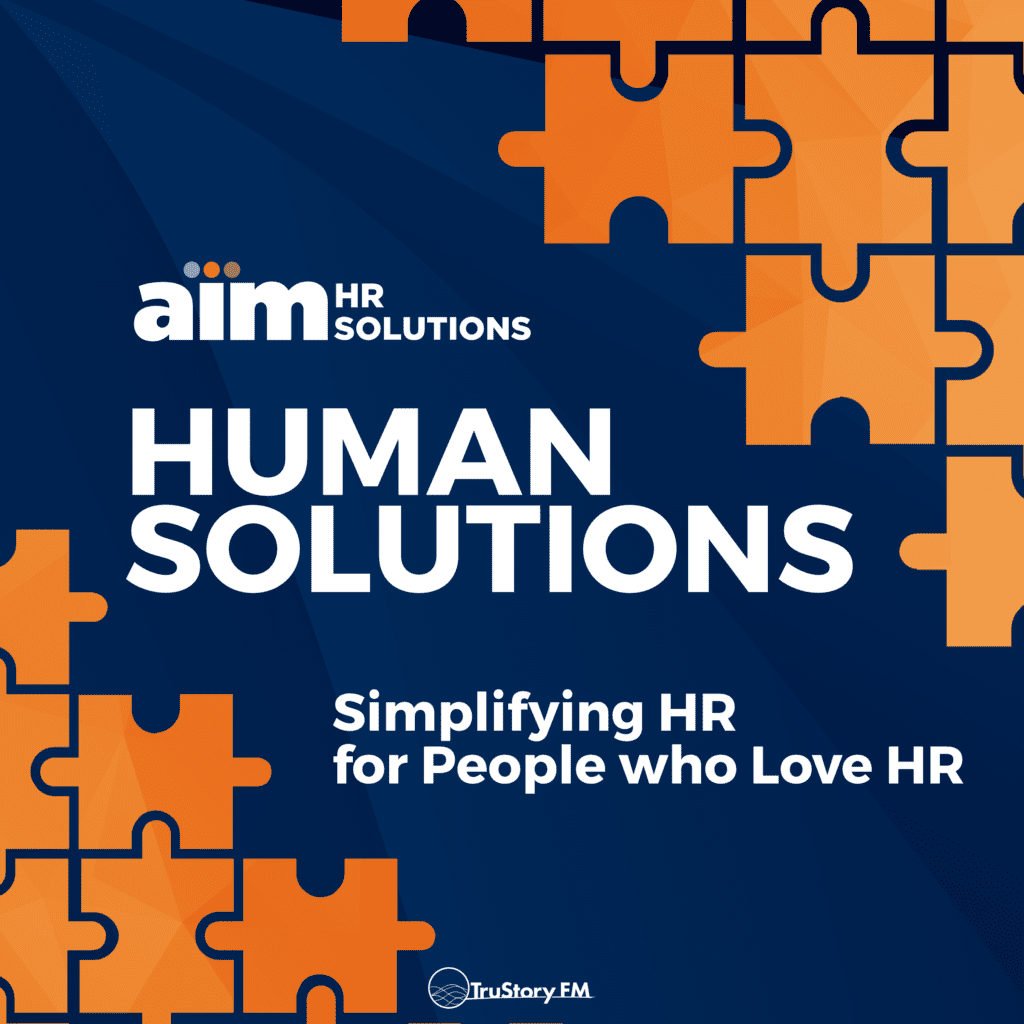This week, we unveil the power of collaboration between HR professionals and learning and development experts to craft bespoke solutions that elevate both employees and the organization. Jen Moff and Kathleen Worthington join Pete Wright to offer an insider’s perspective on the nuanced differences between training and coaching, and unlock the secret to building a thriving learning culture that magnetizes top talent, including millennials and Gen Z.
We’ll explore the transformative impact of investing in training and development to effortlessly bridge generational gaps, forging unified teams and fostering a shared vision of the organization’s goals and values. Join us to acquire cutting-edge insights and strategies from expert HR that will supercharge your organization’s adaptability and success.
Links & Notes
- Learning & Development Trends for 2023 and Beyond
- Why is Professional Development Important? – Professional Development | Harvard DCE
- AIMhrsolutions.com to search our catalog or go to our L&D catalog
Episode Transcript
Pete Wright:
Welcome to Human Solutions, simplifying HR for people who love HR. From AIM HR Solutions on True Story FM. I’m Pete Wright, and this week we unveil the power of collaboration between HR professionals and learning and development experts, who craft bespoke solutions that elevate employees and the organization together. Our own Jen Moff and Kathleen Worthington are back to share their insider’s perspective on the nuance differences between training and coaching, and unlock the secret to building a thriving learning culture that magnetizes top talent, including millennials and Gen Z.
Well, hi everybody. Jen, Kathleen, welcome back. It’s good to have you both here.
Kathleen Worthingon:
Hi. Thank you.
Jen Moff:
Hello. Hi, Pete.
Pete Wright:
Can we talk about what you want to talk about, in terms of this collaboration piece between HR and learning and development? Because I know a lot of people consider learning and development an HR function. I would like to hear how you two see it as augmentative of HR; separate, but augmentative. Maybe making up a word.
Kathleen Worthingon:
No. Learning and development is a standalone department in its own right. It absolutely is, and oftentimes in my career, I’ve been within HR and I’ve also had the function aligned to the business. So it can go in many directions, but truly, I think what we’re trying to do is add value as a business partner. We need to know enough about the business to understand the type of problems that they’re facing, where the business is going from a strategic direction and how we can skill or even upskill the employees. How do we prepare the business? And so we really want to have a seat at the table, as a partner, to help our business leaders prepare, anticipate and solve tough people problems.
Pete Wright:
What are the things you have to overcome to get that seat at the table? And I guess I’m asking about what are the sort of legacy stereotypes that prevent managers from bringing L&D to the table?
Jen Moff:
I think one of the big things that I see, we’re doing a lot of HR training session builds right now, and they have such a large scope of work. An HR generalist has a lot of different types of areas of focus, expertise, responsibility, so to distill down learning and development as just another one of the HR generalists things along with recruiting, along with compliance along… I could rattle off the list of 10 things, but when you have the opportunity to have someone else, who focuses solely on those things and is not encumbered with having to remember legal requirements for this state and this federal law and this circumstance, and having to build benefits package, there’s so many things, that the deeper dive that people like Kathleen and myself are able to do, doesn’t quite happen. Kathleen, would you agree?
Kathleen Worthingon:
150%, Jen. That’s absolutely right. The HR generalist, we’re even the HR director, they wear so many hats in many, many, many organizations. Not everyone is able to have a learning and development function within the HR team, and so they’re wearing so many hats. They’re moving very quickly. Let’s throw in a pandemic. How does that happen? What do we do there? So we’re really able to take that dive, as Jen said, and we’re also able to build the relationships with the business leaders and the managers in a different way, in a different way. We help with performance problems. We partner, we think about what’s the next technology that’s coming. Sometimes it’s technical training and other times it’s the people, the leadership, the supervisory side of training. So we’re able to take that time and we really bring that expertise to the table about adult learning and it needs analysis and evaluation, all those good things. I could go on and on.
Pete Wright:
Well, and I think that… I absolutely hear that, and as I had… In a past life, I was a project management trainer and would go into big organizations and teach entire teams project management, the skills that go into project management. Now, here’s my observation here, is that in those organizations, the learning and development teams, bespoke learning and development teams, were absolute heroes, because they were able to come in, interview the managers and team leaders and say, “What are your problems?”. And when the answer was project management, it wasn’t the, “Okay, we’ll provide a catalog of online trainings that people can take.”. It was, “We’re going to bring people in to teach project management over a week or two weeks and level up the expertise of the entire department or division all at once. We’re going to go from the minor teams and we’re going to become a major league player in the spirit of corporate training development, almost overnight. We’re going to be able to level up our skills and practice, almost overnight.”.
I think that is a… I can’t think of a better testament to the way to think about learning and development in that partnership, but this is what I want to ask you, because I think so much, this is a thing that’s new to me, because of my past relationship, the role of coaching in the learning and development sphere. That’s a thing that is important to you all to talk about today and I’m curious how you pitch or present coaching as part of the L&D bag of tricks.
Jen Moff:
One of the things that I think is really essential for somebody who’s in the L&D field, they have to be really good at getting to understand the root cause of a problem. We are not band-aid people. We don’t just put something on the top, just to check it off and be done. To really succeed in this industry, you have to really understand things from a deep place, because that allows you to identify what the real issue is, what the real opportunity is and the real solution. Sometimes the solution is training. Sometimes you have to rewrite an entire process internally, and there’s no amount of training we can do for you. And sometimes it’s a matter of coaching, where it’s one-on-one, highly targeted, bespoke with an individual. Sometimes it’s a small group that wants to do one of two things. It can be on a spectrum. Kathleen and I were just talking about this yesterday. The one end of the spectrum is reactive; there’s problems we have to fix these things. The other end is proactive; there’s peak performance opportunity here to help people level up.
Kathleen Worthingon:
Oftentimes the easy solution is, “Oh, let’s just send everybody to training or send this person to training.”. I just had a CEO talking to me about this a couple weeks ago, and I’m like, “How do you know it’s training?”. We ask these questions and we’re able to really unpack the problem. And it’s really important, as Jen said, a… What is it? A problem well-defined is a problem half solved. So making sure we’re solving the right problem. And oftentimes it is training, but other times it might be that one-on-one individual targeted, focus session.
Pete Wright:
Okay. That helps me a lot to understand, particularly where the L&D coaching skillset can apply, because it sounds like what you’re saying is it applies first and foremost when you’re helping managers to address their core problems and determine, as you say, what the actual problem is that they want to solve. And secondarily can apply to a group of employees that need individual, bespoke coaching to level up in a particular area, that is outside of skill development that we might normally think of in training and development. Is that a fair assessment?
Kathleen Worthingon:
That is fair. Yeah.
Jen Moff:
Yeah, I think so too.
Pete Wright:
Where does that take us, if we want to create and instill a learning and development culture? Let’s assume that there are some roadblocks to overcome, but for listeners who are HR professionals, listeners to this show who are thinking, “Okay, that’d be awesome, in what parallel universe we have that I could solve these problems with learning and development, or developing my learning and development skill.”. How do we help our listeners level up their L&D game?
Jen Moff:
I know that prior to my working for AIM, there was a small handful of things that people, on an individual level, because companies, it’s made up of individuals, but when we look at it on an individual level, there’s a small grouping of things that people will invest in, will put their money towards; their health, get getting more time or making more money. So if we can tap into the emotional quotient, that is important to a company on an individual level, related to the health of the organization, where the time can be utilized more effectively, more efficiently, more productively, how to make more money. That’s how L&D actually really helps. But oftentimes it’s overly simplified. It’s glossed over, it’s thought about a nice to have, “Oh, well, wouldn’t it be nice to just send somebody to a class?”. They won’t be in the office. They won’t be on the site. They won’t be in the factory. They won’t… But what will they be getting? It’s the difference between cost and investment. The thought that there’s going to be loss by attending this versus what’s received from investing the time and the energy.
Kathleen Worthingon:
Oftentimes, I have to build the business case on the need for the training and also what’s the risk of not doing the training? And then they go, “Wow, I haven’t really thought of it that way.”. But they can come up with a list. And so it’s really important that sometimes we have to go slow to go fast. So that investment that Jen is talking about is key and it really should tie into their strategic plan and align with their strategic business objectives. This isn’t just a nice to have. You know the ice cream truck comes and ding ding, and we’re all going to go get our little treats. Yes, learning can be a treat. Going to training can be a treat, if you’re not able to go very often, but it’s important to the business to grow your business and to retain your employees. They don’t… Yeah. Let’s go there, Pete. Let’s go there.
Pete Wright:
Yeah, I want to go there, Kathleen, because I think there are a couple of complicating factors or I wonder if they’re complicating factors or if they are factors that we, writ large, overcomplicate in our journey toward a learning culture. So I’d love it if we could start by definition of terms, what is a learning culture in your view? And then let’s dive in on how to attract and retain people across generations. It’s one of the things I know was on our hot list of things we wanted to cover today, particularly talking about training and development for millennials and Gen Z, and assessing where just in time training works and doesn’t work. So let’s start with the learning culture. Jen, why don’t you tell us what a learning culture is?
Jen Moff:
Oh, I’ve seen this defined in a couple of different ways. And to me, the learning culture is found in the company’s values and it starts at the top. It’s when a CEO, an executive team has prioritized it, not only for the entry level employee, but even for themselves. So they model what right looks like. So they invest in themselves. They get executive coaching. They attend training classes. They communicate when there’s opportunities to learn, that they put it as part of a comp and benefits package, where maybe they’ve got a software provider or a partnership with AIM HR to provide opportunities to continue your own professional development. And it’s proactive rather than reactive. I think that’s the big thing that I’ve found. What about you, Kathleen?
Kathleen Worthingon:
I couldn’t agree more, Jen. It does start with the values. It does start with modeling at the top and then reinforcing the right behaviors through that training. It starts at day one with onboarding, and it’s not just; we go to a room and we sit down or we get on a screen and we go through a pile of PowerPoints. It’s a continuous, evolving, expected, rewarded process. It’s very organic and it’s part of the way that they behave every day. They’re learning, they’re challenging, they’re going to classes, they’re going to conferences. They have a mentor or a coach, and it’s just baked in to who the company is and what they believe in.
Pete Wright:
Okay, so it doesn’t take me very long, scrubbing through YouTube shorts or TikTok or name the platform, Instagram, to find someone who would be traditionally classified as a millennial or Gen Z who has uncovered something new and is just crowing about it. They love learning and teaching. And so I wonder when I hear complaints about developing learning and development programs that really target the millennials and Gen Zs, if they aren’t a little bit overblown and maybe could be more characterized toward; we don’t know how to do it right yet. So let’s talk a little bit about creating a cross-cultural learning and development plan that can stick.
Kathleen Worthingon:
There you’re talking about the transfer of knowledge, the back and forth, what I call reverse mentoring. So I’m learning from the early careers, they’re learning from me. We both are in the spirit of continuous improvement. We’re sharing and we’re learning and growing together. And what brings us together is that common value of learning, of wanting to increase our knowledge, our technical ability. It’s really exciting when it happens.
Pete Wright:
Well, and that’s a thing that feels cross-generational to me, right?
Kathleen Worthingon:
Yeah.
Pete Wright:
It feels like there are people who love to learn and it doesn’t matter how old they are, what year they were born.
Jen Moff:
Yes. I had a grandfather years ago, I think it was 1999, he was my last grandfather. Everyone else had passed and it was around the time of cell phones just starting to come on the scene. And my dad happened to work for a cell phone company, and so he got a spare one and my mom was like, “Why don’t we get it for my dad?”. So we lived in Georgia at the time, drove up to Pittsburgh, gave it to him, and he was in his nineties, tickled pink, got out the little manual, was reading through it, practicing; “How do you do this? How do you do that?”. I think to some degree, the desire to learn, the desire to expand your mind is inherent to some people more than others and to different degrees. So it’s not surprising. I think when we do see different companies approach it different ways, because it’s based off of the core values, what somebody that came in believes and it’s-
Pete Wright:
And our interpretation of somebody else’s core values.
Jen Moff:
Yes, that projection piece.
Pete Wright:
Mm-hmm.
Kathleen Worthingon:
I think it’s really important now that companies are becoming more vocal, more present with their commitment to learning and development, and they’re leveraging it as a way to attract new talent and to grow their workforce. It’s been a tough time for companies to attract and retain good workers. People have been jumping around, they don’t stay long and one of the things that will really help to attract, retain and engage your employee workforce is a really healthy pipeline of learning tools and classes and a learning culture. I find that people don’t want to feel stuck. They want to know that they can enhance their skillset. They want to grow. And I think this is something that companies need to pay attention to is, that can be a competitive advantage for them. That can be that magnet that brings them in and then also that keeps them there, because if I know that I can keep learning, it doesn’t matter what stage of my career I’m in, that’s exciting to me.
Jen Moff:
I know when I was in college, I had to take a web design class and a layout and design class, and the tools that they were leveraging were not used by people in the same class who had internships for other companies. I was using a layout and design software called Quark that was no longer used in the marketplace. InDesign, Illustrator was used, and this was 2010 time period, and I was an older college student at that time. I was not in my early twenties. I had went back. So you can see the opportunity that a company has to say, “You know what? Let’s see what they’re teaching and the degree programs, see what we can offer that’s going to support somebody right out the gate.”, because 9 times out of 10, like Kathleen said, that’s going to be a real draw for somebody that’s a fresh graduate. And then for people that are at a different point in their career, they maybe are going through some personal changes, life experiences and they want to pivot, but they need opportunities to learn other skills to make a change in their career path.
Pete Wright:
I want to pivot just a little bit on that point specifically, how do you build a learning and development program internally that competes with YouTube?
Kathleen Worthingon:
You don’t.
Pete Wright:
Kathleen, to your point, maybe compete is the wrong word, but I’m really curious, because when I need to learn something new and I am not a younger person anymore, oh my goodness. When I need to learn something new, I go to YouTube and I find somebody who can demonstrate how a thing works and can give me ideas on putting my own spin on a thing, and that’s how I learn. Whether it’s a new software tool, whether it’s a new piece of technology, whatever it is. And I’m curious if that is something that… What is the degree of maturity that learning and development teams, best in class learning and development teams, are pushing toward?
Jen Moff:
Here’s the thing that you said though, you talked primarily about technical, so soft skills can be talked about in a video. Kathleen and I, we could go to a studio right now, we could set up some stuff, we could role play, film it and put it on YouTube for you. But the practice, the hands on practice that you get from a live coach, that you get from instructor-led, in-person or virtual training is different than just watching something. There is a place for that. I know that there was a huge movement a couple of years ago for e-learning, like that’s the way it’s going to go. And yet there is something to be said for what it can’t do. It can provide information, but it doesn’t give you accountability. It doesn’t give you encouragement, it doesn’t help you see your blind spots. There’s things that it does lack. And so if we’re looking to, as you said, compete, we need to be aware of what its strengths are and what it fails to do and fill in those gaps.
Kathleen Worthingon:
Oh, this is a good one, Pete, if we still have a little time for this one. Jen is right on with this one. I would also say in my past, I headed up learning and development teams within a company, a large corporation, and we didn’t do it all. We had our in-house technical trainers, we had some of our leadership programs, but we went outside to an AIM HR, because we knew we didn’t have the bandwidth nor the expertise to do it all. And we had the static courses, the e-learning, as Jen mentioned, we had a suite of that, and what we built was a blended learning solution. And I think that I looked to companies, I would research like crazy to find the AIM Hrs, that I could partner with and collaborate with and come in and build a relationship with, and my people would have a relationship with them. So that’s what… I mean, we really offer that. We offer those solutions. We’re not all things for all people. Right, Jen? We’re not pretending to do it all. We have our lean, and I’d like to say we’re doing our lean pretty well.
Pete Wright:
Well, this has been a wonderful learning experience for me with you both, as it always is. Thank you so much for hanging out. I’ve got a couple of links in the resources, in the show notes. Is there any place you want to point people specifically to learn more about the kind of work you’re doing or resources that you love, that will help others learn how to push their L&D forward?
Jen Moff:
That’s a fantastic question. You can check out our content library on our website, aimhrsolutions.com. If you search for catalog or go to the learning and development menu icon and go to catalog, you’ll see our entire list of sessions, including what courses we offer publicly, and I’m sure that there’s going to be something, whether it’s related to HR, compliance, leadership, professional development, that might be available to solve a problem or proactively create some opportunities for where you are right now.
Pete Wright:
Perfect. Kathleen, what’s your favorite resource right now?
Kathleen Worthingon:
My favorite resource. All of the above. I don’t… How can I say? I love that our catalog is refreshed on a regular basis, so I know that when I go there, I can trust what’s in there is relevant and ready.
Pete Wright:
Thank you both, again. Great conversation today. I hope you listeners have learned a bunch about ways you can push your own L&D forward. As always, look for the link, it’s in the show notes. Just scroll up in your podcast player, you’ll find them right down below, right down below. I promise they’re right there. You can listen to the show on the website at aimhrsolutions.com or of course, subscribe where finer podcasts are served. On behalf of Kathleen Worthington and Jen Moff, I’m Pete Wright. We’ll see you next week right here on Human Solutions, simplifying HR for people who love HR.











